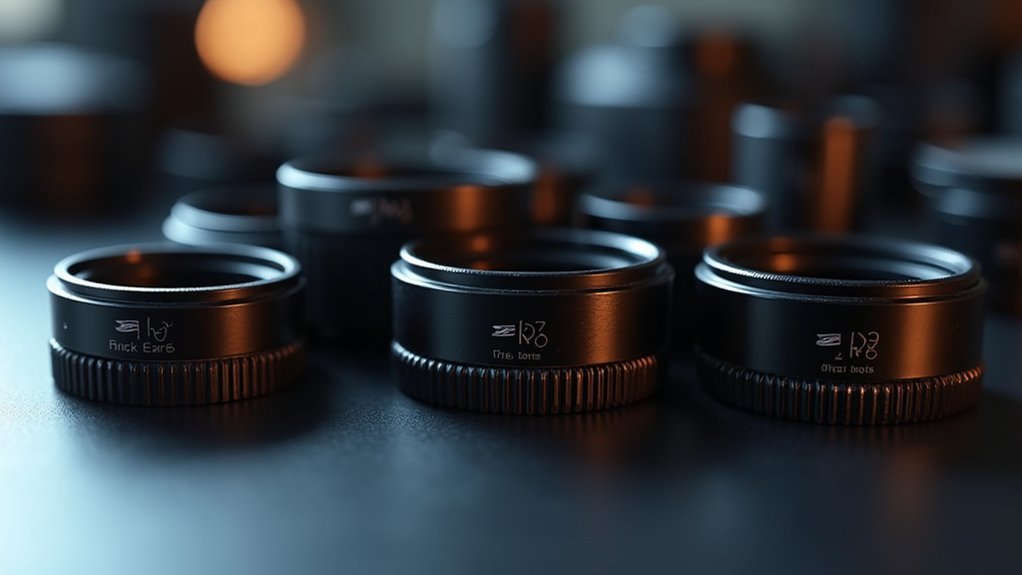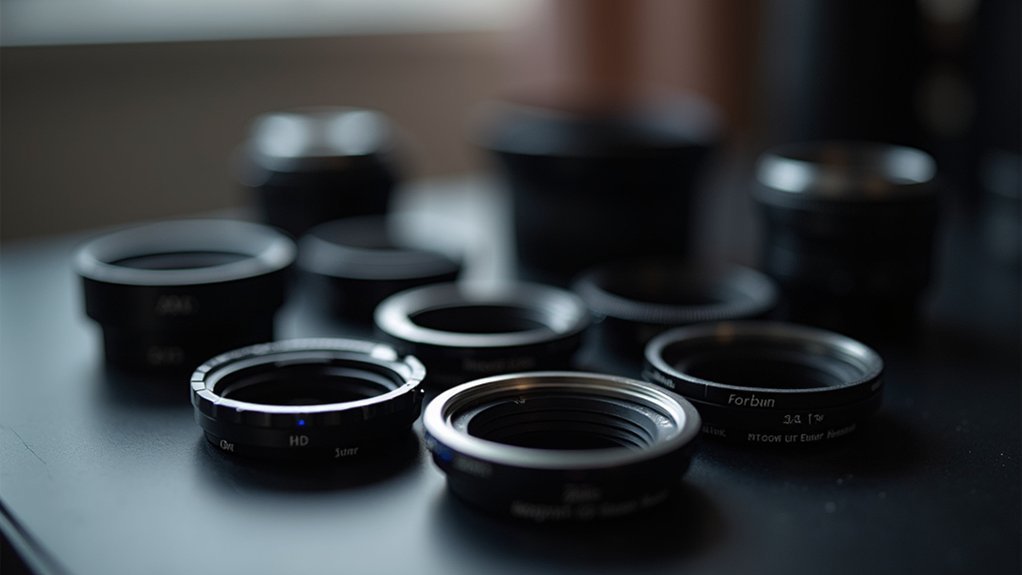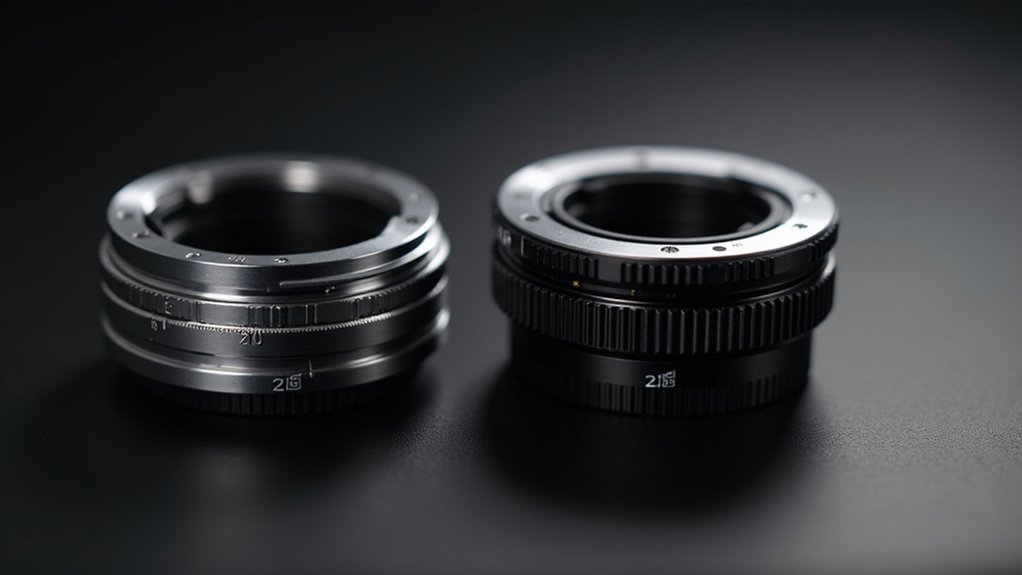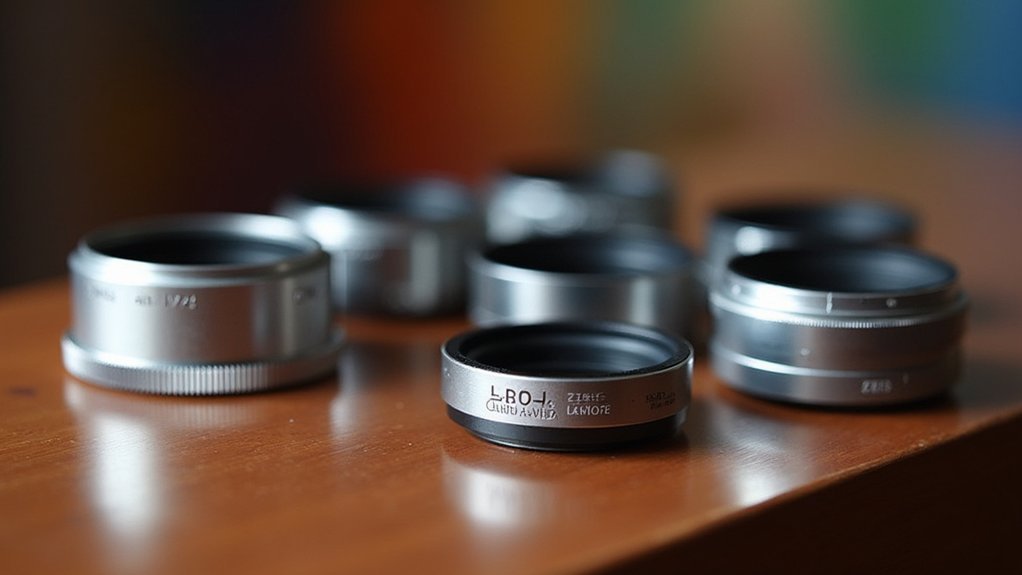Zeiss photo adapters vary by your specific camera system and spotting scope. You’ll need to match both the mount type (ZE for Canon, ZF.2 for Nikon, ZK for Pentax) and the correct thread size (M49, M52, or M58). Check your equipment specifications and consult Zeiss’s Mount Compatibility Chart before purchasing. Avoid stacking multiple adapters to prevent vignetting. Proper alignment guarantees peak image quality and functionality. The right adapter makes all the difference in your field photography results.
Understanding Zeiss Adapter Mount Types

Five distinct mount types define the Zeiss photo adapter ecosystem, each engineered for specific camera systems.
When selecting a lens adapter, you’ll need to match your camera’s requirements with the appropriate Zeiss mount type.
The ZE series features an EF bayonet mount designed for Canon systems, offering electronic shutter control and full exposure compatibility.
For Nikon users, ZF.2 lenses provide an electronic interface with manual aperture control across various exposure modes.
Pentax photographers can utilize ZK lenses with their manually focusable design and KA standard aperture coupling.
If you’re using classic equipment, the ZS series with M42 screw threads might be your solution.
These adapters connect to objective lenses with filter threads, available in multiple sizes including M49, M52, and M58 to accommodate different optical setups.
Matching Adapters to Your DSLR Camera System
When selecting the ideal Zeiss adapter for your DSLR camera, understanding the specific compatibility requirements of your system guarantees peak performance and functionality.
Different camera brands require specific adapter series for seamless integration.
Each camera manufacturer demands its own unique Zeiss adapter series to ensure flawless connectivity and optimal performance.
If you’re a Nikon user, ZF.2 adapters provide electronic control while still allowing you to manually set apertures on non-electronic bodies.
Canon EOS photographers should opt for ZE lenses that work with all exposure programs and transmit lens data to your camera.
Pentax owners need ZK lenses with their K bayonet mounts featuring electronic contact pins.
For specialized setups, Zeiss offers photo adapters in M49, M52, and M58 sizes to connect spotting scopes to various system cameras, while M42 screw thread users can utilize ZS lenses with push-pin aperture control.
ZE vs. ZF.2 Lens Compatibility Guide

Understanding the distinct features of ZE and ZF.2 lens systems helps you match the right Zeiss optics to your camera body.
When you choose Carl Zeiss lenses, you’ll need to take into account your camera’s mount type.
ZE lenses are built specifically for Canon EOS cameras with EF mounts, providing electronic shutter control and full exposure program support. They transmit lens information directly to your camera body.
In contrast, ZF.2 lenses work with Nikon DSLRs that have electronic interfaces. They feature a lockable aperture ring at the largest f-stop for electronic control, though they don’t transmit focus distance information.
Both lens types support manual focus for precise control.
Critical Measurements for Proper Adapter Selection
Selecting the right Zeiss photo adapter requires precise measurements to confirm perfect compatibility between your camera and spotting scope.
Start by measuring your spotting scope’s filter thread diameter, confirming whether it’s M49, M52, or M58—this must match your adapter’s connection size.
The precise measurement of your scope’s filter thread—whether M49, M52, or M58—ensures seamless adapter compatibility.
Check if your adapter is specifically designed for your Zeiss model, such as the Conquest Gavia. An exact fit guarantees ideal performance and prevents potential damage to both pieces of equipment.
Don’t overlook the adapter’s functionality specifications, verifying it supports features like image stabilization or electronic control if you need these capabilities.
Finally, consider the weight distribution of your complete setup. The right adapter won’t just connect your camera—it’ll maintain balance and stability during field use.
Preventing Vignetting With the Right Adapter Configuration

To prevent vignetting when using Zeiss adapters, you’ll need to understand how adapter stack height affects your optical path.
Proper flange distance calculations guarantee your image sensor remains at the ideal distance from your lens elements, maintaining edge-to-edge clarity.
You can minimize light falloff by choosing adapter configurations that maintain the lens’s designed angle of view while limiting the total adapter height.
Vignetting Prevention Subheadings
When light struggles to reach the edges of your frame due to improperly configured adapters, vignetting becomes an immediate concern for Zeiss lens users.
The Bay60-to-72mm threaded adapter offers a solution by maintaining a wider opening for light entry, especially beneficial when stacking filters.
Be mindful that each additional adapter increases vignetting risk, particularly with wide-angle lenses. Always check lens hood compatibility with your adapter setup to prevent unwanted darkening at the frame edges.
Consider standardizing on larger filter sizes like 77mm to simplify your accessory collection while minimizing vignetting risks. This approach creates a more versatile system across different lenses.
Finally, evaluate your filter choices carefully—polarizers and other specialized filters can worsen vignetting issues if not properly matched to your lens configuration.
Adapter Stack Height Matters
The physical height of your adapter stack directly impacts image quality when using Zeiss lenses. When you stack multiple adapters, you’re increasing the distance between your lens and sensor, potentially causing vignetting with wide-angle lenses.
| Adapter Configuration | Stack Height | Vignetting Risk |
|---|---|---|
| Single Dedicated Adapter | Minimal | Low |
| Two Stacked Adapters | Moderate | Medium |
| Three+ Stacked Adapters | Excessive | High |
Always opt for thinner, single-piece adapters when possible. This maintains the ideal light path to your sensor and preserves the lens’s intended angle of view. Before purchasing, verify compatibility with your specific Zeiss lens—particularly with wide-angle optics where every millimeter counts. Remember, the right adapter configuration isn’t just about fit; it’s about maintaining the exceptional image quality Zeiss lenses are designed to deliver.
Flange Distance Calculations
Three critical measurements determine whether your Zeiss lens will perform perfectly with an adapter: the source mount’s flange distance, the target mount’s flange distance, and the adapter’s thickness.
Getting these calculations right prevents vignetting—those distracting dark corners that ruin your images.
To calculate the proper adapter thickness, subtract the target mount’s flange distance from the source mount’s flange distance. For example, when adapting a Nikon lens (46.5mm) to a Canon camera (44mm), you’ll need an adapter precisely 2.5mm thick.
If your adapter is too thin, you’ll lose infinity focus. If it’s too thick, your lens won’t focus properly at any distance.
For best results, choose Zeiss adapters that maintain or slightly increase the correct flange distance for your specific camera-lens combination.
Bayonet vs. Threaded Mount Adapters: Pros and Cons

Choosing between bayonet and threaded mount adapters for your Zeiss lenses involves weighing several key factors that affect both shooting efficiency and image quality. Bayonet mounts offer notably faster lens changes during shoots, while threaded mounts provide more secure connections that won’t accidentally detach.
| Feature | Bayonet Mount | Threaded Mount |
|---|---|---|
| Speed | Quick attachment/detachment | Slower, requires rotation |
| Security | Good, but less secure | Excellent, minimal risk |
| Electronic Communication | Often supported | Limited or none |
| Compatibility | System-specific (EF, F, K, M42) | May need additional adapters |
You’ll find bayonet mounts excel when electronic features like autofocus are needed, whereas threaded mounts often perform better in manual focus situations. Consider also that stacked threaded adapters may increase vignetting risks compared to properly designed bayonet systems.
Adapting Microscopes for Digital Photography
When adapting your Zeiss Axiotech microscope for digital photography, you’ll need to select a trinocular head that matches your camera’s sensor size to maximize image quality.
The right combination of adapter and camera prevents vignetting, where dark corners appear in your photomicrographs due to optical incompatibility.
You can use the online configurator to find the perfect LM digital adapter for your specific setup, ensuring full-frame illumination across your camera’s sensor.
Selecting Optimal Trinocular Heads
Why settle for standard binocular viewing when you can transform your microscope into a powerful imaging system? Trinocular heads provide the perfect solution, offering dedicated camera ports while maintaining comfortable viewing through both eyepieces. You’ll appreciate the adjustable diopters that guarantee perfect alignment between what you see and what your camera captures.
| Head Type | Key Benefits | Ideal For |
|---|---|---|
| Standard Trinocular | Basic camera integration | Entry-level photography |
| Ergonomic Trinocular | Reduced neck strain | Extended imaging sessions |
| Professional Grade | Premium optics, precise alignment | High-resolution documentation |
When choosing your trinocular setup, consider compatibility with LM digital adapters, which simplify connecting various cameras from DSLRs to mirrorless systems. This flexibility guarantees your microscope can evolve alongside your imaging needs while maintaining peak performance.
Minimizing Vignetting Issues
Those dark shadows creeping around the edges of your microscope images can ruin otherwise perfect specimens. To combat vignetting when using Zeiss photo adapters, select appropriate LM digital SLR adapters that maintain image quality while preserving the full field of view.
Avoid stacking multiple adapters or filters whenever possible, as each additional element increases the risk of edge darkening. Instead, opt for single adapters that properly fit your system.
When filters are necessary, choose standardized larger diameters (72mm) to minimize vignetting effects.
Consider upgrading to observation eyepieces with 30mm diameter for an enhanced field of vision when connecting digital cameras.
Always guarantee proper alignment and secure fitting of your adapters to achieve peak photographic results. These simple adjustments will keep your microscope images clear and fully illuminated from edge to edge.
Spotting Scope to Camera Connection Solutions

While traditional photography has its limitations, Zeiss Photo Lens Adapters bridge the gap between spotting scopes and digital cameras. These ingenious adapters transform your Conquest Gavia spotting scope into a powerful telephoto lens, dramatically extending your camera’s reach.
Available in M49, M52, and M58 sizes, you’ll need to identify which adapter matches your equipment. The M49 filter thread specification works specifically with Zeiss Conquest Gavia models, ensuring proper alignment and stability during use.
You’ll appreciate how these adapters maintain image quality while providing versatility for wildlife photography, birdwatching, and other outdoor pursuits.
Simply attach your camera to your spotting scope, and you’re ready to capture distant subjects with remarkable detail. This connection solution eliminates the need for expensive super-telephoto lenses while leveraging optics you already own.
Filter Thread Considerations for Zeiss Adapters
Before purchasing any Zeiss photo adapter, you’ll need to identify the correct filter thread size for your specific equipment.
Zeiss offers adapters in M49, M52, and M58 sizes, each designed to match specific objective lenses and their corresponding threads.
If you’re using a Conquest Gavia spotting scope, you’ll need the M49 adapter for ideal connection and performance.
Remember that improper sizing can lead to functionality issues and potential damage to your equipment.
When selecting your adapter, consider these key factors:
- Check your lens specifications for the exact filter thread measurement
- Avoid stacking multiple adapters, as this can cause vignetting, especially with wide-angle lenses
- Verify if your Zeiss lens uses a bayonet mount, which offers additional filter flexibility
Full-Frame vs. Crop Sensor Adapter Requirements
Choosing the appropriate Zeiss photo adapter requires understanding how your camera’s sensor size impacts compatibility and performance.
Full-frame cameras need adapters that support larger image circles to prevent vignetting and maintain image quality across the entire sensor. These adapters typically accommodate larger diameter filters, giving you more versatility with accessories.
Choosing full-frame adapters ensures optimal image quality and greater flexibility with larger diameter filters and accessories.
If you’re using a crop sensor camera, you’ll have more flexibility with smaller adapters designed specifically for reduced sensor sizes. However, be aware that these may limit electronic communication with your lens, potentially affecting autofocus and exposure settings.
When selecting your Zeiss adapter, verify it matches your specific mount type—whether you’re using a Canon EF or Nikon ZF.2 system.
Additionally, consider how your chosen lens’s focal length will perform differently between full-frame and crop sensor configurations.
Electronic Interface Limitations With Third-Party Adapters
Although Zeiss lenses are renowned for their optical quality, pairing them with third-party adapters often introduces significant electronic compatibility challenges.
When you’re considering non-Zeiss adapters, you’ll encounter several functional limitations that may affect your shooting experience.
These limitations typically include:
- Disabled autofocus and exposure communication, forcing you to focus manually and calculate exposure settings yourself.
- Loss of aperture control electronics, restricting your access to automatic exposure modes and requiring stopped-down metering.
- Absence of image stabilization functionality and lens data transmission to your camera body.
The extent of these limitations varies considerably between different camera systems.
Before investing in a third-party adapter for your Zeiss glass, carefully research specific compatibility with your camera to guarantee you won’t sacrifice essential features for your photography needs.
Specialty Adapters for Industrial Applications
While consumer photography demands flexibility and automation, industrial applications require specialized tools with predictable, repeatable performance. For these scenarios, Zeiss offers ZF lenses without CPU coupling or automatic aperture control.
These adapters provide high-quality optics without electronic interference that might compromise precision in industrial settings.
If you’re working with industrial equipment, consider Zeiss’s ZS lenses featuring M-42 screw threads with manual push-pin aperture control.
These specialty adapters guarantee compatibility with industrial cameras that may lack electronic interfaces but still need exposure metering capabilities.
You’ll find these industrial-focused adapters particularly valuable when precision manual focusing is critical. Their robust construction withstands demanding industrial environments while maintaining Zeiss’s renowned optical quality.
Industrial precision demands robust tools that perform reliably when high-accuracy focusing is non-negotiable.
When selecting adapters for industrial applications, prioritize mechanical reliability over electronic features for consistent, dependable performance.
Troubleshooting Common Adapter Fit Issues
When your Zeiss photo adapter doesn’t fit properly, first consult the Mount Compatibility Chart to verify your camera and spotting scope are designed to work together.
Check that you’ve selected the correct Adapter Ring Sizing (M49, M52, or M58) to match your spotting scope’s filter thread dimensions.
For Loose Connection Solutions, make sure all contact surfaces are clean of debris, use the appropriate tension settings if available, and consider adding rubber o-rings for a more secure fit in cases where minor thread wear has occurred.
Mount Compatibility Chart
Photographers often encounter frustrating fit issues when pairing Zeiss adapters with their equipment.
Understanding which mount works with your specific camera and lens combination is essential for seamless integration. Our compatibility chart simplifies this process by matching adapter types to camera systems.
1. M49 Adapters – Compatible with entry-level Zeiss spotting scopes and smaller DSLRs with standard filter threads.
Works primarily with Conquest series scopes.
2. M52 Adapters – Designed for mid-range cameras when paired with Victory FL and Diascope models.
Ideal for Nikon F-mount cameras using ZF.2 lenses.
3. M58 Adapters – Fits professional-grade equipment and larger diameter lenses.
Best option for Canon EF mounts and high-end Victory spotting scopes with specialized threads.
Always verify your camera’s mount type before purchasing to confirm you’re selecting the correct Zeiss adapter for your setup.
Adapter Ring Sizing
Despite their precision engineering, Zeiss adapters often create frustrating fit issues if you’re using incorrectly sized rings. The most common problem stems from mismatched filter thread sizes between your spotting scope and the adapter.
Always verify that popular sizes like M49, M52, or M58 match your objective lens specifications.
When troubleshooting attachment problems, first check that your camera’s lens mount type (EF, F, K, or M42) is compatible with your chosen adapter.
Vignetting—those dark corners in your images—typically indicates an adapter that’s too narrow for your optical setup.
Pay attention to adapter thickness as well. Bulky designs can interfere with focusing mechanisms or create unwanted distance between optical elements.
For best results, your adapter should create a seamless connection without compromising the performance of either component.
Loose Connection Solutions
Loose or unstable adapter connections can quickly ruin a perfect photo opportunity, especially during wildlife or sports photography sessions. When your Zeiss photo adapter isn’t staying firmly attached, several factors may be at play.
First, confirm the thread sizes match perfectly between your adapter and spotting scope—M49, M52, or M58 connections must be properly aligned for stability.
- Inspect both adapter and lens threads for debris or damage that could prevent secure attachment.
- Apply appropriate torque when tightening—firm enough for stability but not so tight you risk stripping threads.
- Consider adding a rubber or silicone grip ring between components to eliminate slippage.
If problems persist despite these adjustments, verify compatibility between your specific equipment by consulting Zeiss’s manufacturer specifications for your particular camera and lens combination.
Frequently Asked Questions
Can I Use Any Lens on Any Camera With Adapter?
No, you can’t use any lens on any camera with adapters. They’re limited by mount compatibility, and even with adapters, you’ll often lose features like autofocus or electronic aperture control.
What Mount Are ZEISS Lenses?
ZEISS lenses come in various mounts: EF bayonet (ZE) for Canon, F bayonet (ZF.2) for Nikon, K bayonet (ZK) for Pentax, and M42 screw threads (ZS). You’ll need to match your camera’s system with the correct mount.
How Do I Choose a Lens Adapter?
To choose a lens adapter, you’ll need to identify your camera’s mount type, check electronic compatibility, consider filter thread size, evaluate needed functionality, and make certain it suits your photography needs.
Do Lens Mount Adapters Affect Image Quality?
Yes, lens mount adapters can affect image quality. You’ll notice potential issues like reduced sharpness, increased vignetting, and light loss. High-quality adapters without optical elements will minimize these negative impacts on your images.
In Summary
Finding the right Zeiss photo adapter requires knowing your camera’s mount type and sensor size. You’ll need to match ZE (Canon) or ZF.2 (Nikon) lenses with the appropriate adapter for your system. Don’t forget to check flange distance measurements and electronic compatibility. If you’re experiencing vignetting or fit issues, verify that you’ve selected an adapter specifically designed for your camera body and lens combination.





Leave a Reply